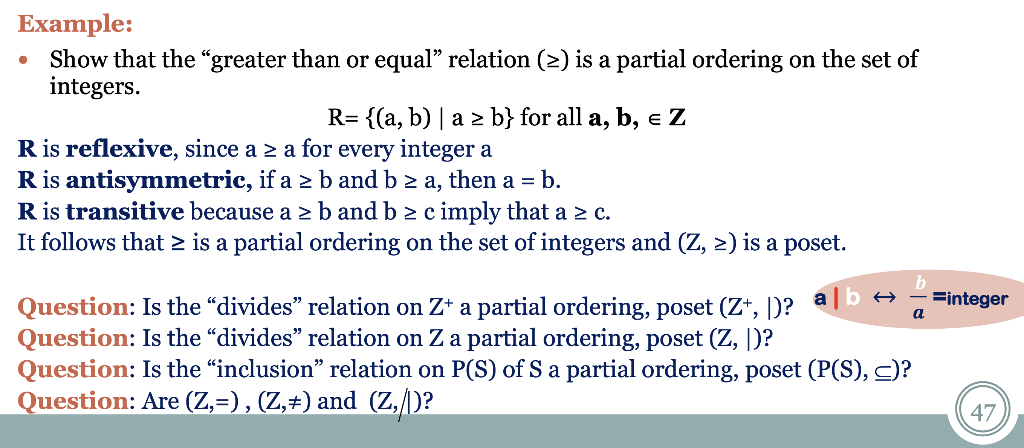Home /
Expert Answers /
Computer Science /
example-show-that-the-34-greater-than-or-equal-34-relation-geq-is-a-partial-ordering-on-th-pa630
(Solved): Example: - Show that the "greater than or equal" relation \( (\geq) \) is a partial ordering on th ...
Example: - Show that the "greater than or equal" relation \( (\geq) \) is a partial ordering on the set of integers. \[ \mathrm{R}=\{(\mathrm{a}, \mathrm{b}) \mid \mathrm{a} \geq \mathrm{b}\} \text { for all } \mathbf{a}, \mathbf{b}, \in \mathbf{Z} \] \( \mathbf{R} \) is reflexive, since a \( \geq \) a for every integer a \( \mathbf{R} \) is antisymmetric, if \( a \geq b \) and \( b \geq a \), then \( a=b \). \( \mathbf{R} \) is transitive because \( a \geq b \) and \( b \geq c \) imply that \( a \geq c \). It follows that \( \geq \) is a partial ordering on the set of integers and \( (Z, \geq) \) is a poset. Question: Is the "divides" relation on \( \mathrm{Z}^{+} \)a partial ordering, poset \( \left(\mathrm{Z}^{+}, \mid\right) \)? \( \quad \) a \( \mid b \leftrightarrow \frac{b}{a}= \) integer Question: Is the "divides" relation on \( \mathrm{Z} \) a partial ordering, poset \( (\mathrm{Z}, \mid) \) ? Question: Is the "inclusion" relation on \( \mathrm{P}(\mathrm{S}) \) of \( \mathrm{S} \) a partial ordering, poset \( (\mathrm{P}(\mathrm{S}), \subseteq) \) ? Question: Are \( (\mathrm{Z},=),(\mathrm{Z}, \neq) \) and \( (\mathrm{Z}, \|) \) ?
Expert Answer
To show that a relation is a partial ordering on a set, we need to show that it is reflexive, antisymmetric, and transitive. First, let's consider the
